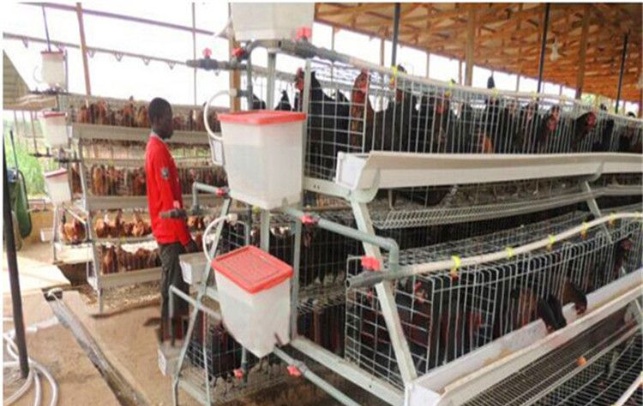Efisiensi dan Kesejahteraan Peternakan Ayam Kandang Baterai
Waktu :2024-05-14
Battery cage chicken farming has long been a staple in the poultry industry, providing a practical solution for housing large numbers of birds in a controlled environment. However, the traditional approach to battery cages has faced criticism for its potential impact on animal welfare. In response to these concerns, modern advancements in battery chicken cages have emerged, prioritizing both efficiency and welfare. Let’s explore how these innovations are reshaping the landscape of poultry farming.
Evolusi dari Battery Chicken Cages: Balancing Efficiency and Welfare
Traditional Battery Cage SystemsHistorically, battery cage systems have been characterized by their compact design, allowing for high stocking densities within poultry facilities. While these systems offer efficient use of space and streamlined management processes, they have been criticized for their limited space allowance and potential welfare implications for the birds.
Pengenalan Modern Battery Chicken CagesIn recent years, there has been a shift towards modern battery chicken cages that aim to address the shortcomings of traditional systems while maintaining efficiency and productivity. These modern cages prioritize animal welfare by incorporating features such as increased space allowance, improved ventilation, and enhanced amenities for the birds.
Keunggulan Modern Battery Chicken Cages
Enhanced Welfare StandardsModern battery chicken cages are designed to provide birds with more space and improved living conditions compared to traditional systems. By prioritizing welfare considerations, these cages aim to minimize stress and promote healthier growth and development among the poultry flock.
Optimized Production EfficiencyDespite the focus on welfare, modern battery chicken cages still offer significant advantages in terms of production efficiency. With features such as automated feeding and watering systems, waste management solutions, and### Maximizing Efficiency and Welfare in Battery Cage Chicken Farming
Battery cage chicken farming has long been a contentious topic in the poultry industry, with debates surrounding animal welfare and production efficiency. However, with advancements in cage design and management practices, it’s possible to strike a balance between productivity and the well-being of the birds. Let’s delve into the intricacies of battery chicken cages and how they can be optimized to maximize both efficiency and welfare.

Memahami Battery Chicken Cages
Battery chicken cages are a type of housing system used in intensive poultry farming, characterized by their stacked, multi-tiered design. These cages are typically made of wire mesh and are designed to house multiple birds in a confined space, with each bird allocated a small individual compartment.
Key Features of Battery Chicken Cages
- High Stocking Density: Battery cages allow for high stocking densities, maximizing the number of birds that can be housed within a given area.
- Efficient Space Utilization: The vertical stacking of cages optimizes space utilization, making them suitable for large-scale commercial poultry operations.
- Ease of Management: Battery cages simplify management tasks such as feeding, watering, and egg collection, streamlining farm operations.
Meningkatkan Kesejahteraan di Battery Cage Systems
While battery cages have been criticized for their impact on animal welfare, there are measures that can be taken to improve conditions for the birds within these systems.
Enriched Environments: Providing environmental enrichment, such as perches, nesting areas, and dust baths, can enhance the well-being of birds housed in battery cages by allowing for natural behaviors.
Proper Management Practices: Implementing strict management practices, such as regular health checks, proper ventilation, and adequate nutrition, is essential for maintaining the health and welfare of birds in battery cage systems.
Transition to Alternative Systems: In some cases, transitioning to alternative housing systems, such as enriched colony cages or free-range systems, may be a viable option for improving animal welfare while maintaining productivity.
Balancing Efficiency and Welfare
Menemukan keseimbangan antara efisiensi dan kesejahteraan adalah hal yang terpenting dalam battery cage chicken farming. By implementing best practices and incorporating advancements in cage design and management, it’s possible to optimize productivity while ensuring the well-being of the birds.
Improved Cage Design: Innovations in cage design, such as larger cage sizes, improved flooring materials, and better ventilation systems, can contribute to enhanced welfare outcomes for birds housed in battery cages.
Focus on Health and Comfort: Prioritizing the health and comfort of the birds through measures such as proper nutrition, disease prevention, and environmental control can mitigate the negative impacts of confinement in battery cage systems.
Conclusion: A Path Forward
Peternakan ayam kandang baterai remains a significant aspect of the poultry industry, providing an efficient means of egg production for millions of consumers worldwide. While challenges regarding animal welfare persist, advancements in cage design, management practices, and consumer awareness offer opportunities for improvement. By continuously striving to optimize both efficiency and welfare, we can ensure a sustainable and ethical future for battery cage chicken farming.




 Indonesia
Indonesia
 English
English Español
Español






